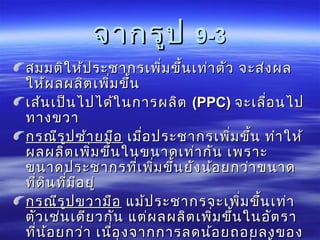аёһаёұаёВХёҷаёІа№ҖаёЁаёЈаё©аёҗаёҒаёҙаёҲ
- 1. аёҡаё—аё—аёөа№Ҳаёҡаё—аё—аёөа№Ҳ 1010 аёҒаёІаёЈаёһаёұаё’аёҷаёІаёҒаёІаёЈаёһаёұаё’аёҷаёІ а№ҖаёЁаёЈаё©аёҗаёҒаёҙаёҲа№ҖаёЁаёЈаё©аёҗаёҒаёҙаёҲ 9.19.1 аё„аё§аёІаёЎаё«аёЎаёІаёўаёӮаёӯаёҮаёҒаёІаёЈаёһаёұаё’аёҷаёІаё„аё§аёІаёЎаё«аёЎаёІаёўаёӮаёӯаёҮаёҒаёІаёЈаёһаёұаё’аёҷаёІ а№ҖаёЁаёЈаё©аёҗаёҒаёҙаёҲа№ҖаёЁаёЈаё©аёҗаёҒаёҙаёҲ 9.29.2 аё”аёұаёҠаёҷаёөаёҠаёөа№үаё§аёұаё”аёЈаё°аё”аёұаёҡаёҒаёІаёЈаёһаёұаё’аёҷаёІаё”аёұаёҠаёҷаёөаёҠаёөа№үаё§аёұаё”аёЈаё°аё”аёұаёҡаёҒаёІаёЈаёһаёұаё’аёҷаёІ а№ҖаёЁаёЈаё©аёҗаёҒаёҙаёҲа№ҖаёЁаёЈаё©аёҗаёҒаёҙаёҲ 9.39.3 аё—аёӨаё©аёҺаёөаёҒаёІаёЈаёһаёұаёВХёҷаёІа№ҖаёЁаёЈаё©аёҗаёҒаёҙаёҲаё—аёӨаё©аёҺаёөаёҒаёІаёЈаёһаёұаёВХёҷаёІа№ҖаёЁаёЈаё©аёҗаёҒаёҙаёҲ
- 2. 9.19.1 аё„аё§аёІаёЎаё«аёЎаёІаёўаёӮаёӯаёҮаёҒаёІаёЈаёһаёұаё’аёҷаёІаё„аё§аёІаёЎаё«аёЎаёІаёўаёӮаёӯаёҮаёҒаёІаёЈаёһаёұаё’аёҷаёІ а№ҖаёЁаёЈаё©аёҗаёҒаёҙаёҲа№ҖаёЁаёЈаё©аёҗаёҒаёҙаёҲ пӮ§ аёҒаёІаёЈаёһаёұаёВХёҷаёІа№ҖаёЁаёЈаё©аёҗаёҒаёҙаёҲаёҒаёІаёЈаёһаёұаёВХёҷаёІа№ҖаёЁаёЈаё©аёҗаёҒаёҙаёҲ ((EconomicEconomic Development)Development) аё«аёЎаёІаёўаё–аё¶аёҮаё«аёЎаёІаёўаё–аё¶аёҮ аёҒаёІаёЈа№Җаё•аёҙаёҡа№Ӯаё•аё—аёІаёҮа№ҖаёЁаёЈаё©аёҗаёҒаёҙаёҲаё«аёЈаё·аёӯаёҒаёІаёЈаёҒаёІаёЈа№Җаё•аёҙаёҡа№Ӯаё•аё—аёІаёҮа№ҖаёЁаёЈаё©аёҗаёҒаёҙаёҲаё«аёЈаё·аёӯаёҒаёІаёЈ а№Җаёһаёҙа№ҲаёЎаёӮаё¶а№үаёҷаёӮаёӯаёҮаёЈаё°аё”аёұаёҡаё”аёұаёҡรายไดа№үаё—аёөа№Ҳа№Ғаё—а№үаёҲаёЈаёҙаёҮа№Җаёһаёҙа№ҲаёЎаёӮаё¶а№үаёҷаёӮаёӯаёҮаёЈаё°аё”аёұаёҡаё”аёұаёҡรายไดа№үаё—аёөа№Ҳа№Ғаё—а№үаёҲаёЈаёҙаёҮ аёӮаёӯаёҮаёӣаёЈаё°а№Җаё—аёЁаёӮаёӯаёҮаёӣаёЈаё°а№Җаё—аёЁ аёӢаё¶а№ҲаёҮа№ҖаёҒаёҙаё”аё„аё§аёҡаё„аё№а№ҲไаёӣаёҒаёұаёҡаёҒаёІаёЈа№ҖаёӣаёҘаёөа№Ҳаёўаёҷа№ҒаёӣаёҘаёҮаёӢаё¶а№ҲаёҮа№ҖаёҒаёҙаё”аё„аё§аёҡаё„аё№а№ҲไаёӣаёҒаёұаёҡаёҒаёІаёЈа№ҖаёӣаёҘаёөа№Ҳаёўаёҷа№ҒаёӣаёҘаёҮ а№Ӯаё„аёЈаёҮаёӘаёЈа№үаёІаёҮаё—аёІаёҮа№ҖаёЁаёЈаё©аёҗаёҒаёҙаёҲа№ҒаёҘаё°аё”а№үаёІаёҷаёӯаё·а№Ҳаёҷа№Ӯаё„аёЈаёҮаёӘаёЈа№үаёІаёҮаё—аёІаёҮа№ҖаёЁаёЈаё©аёҗаёҒаёҙаёҲа№ҒаёҘаё°аё”а№үаёІаёҷаёӯаё·а№Ҳаёҷ а№Ҷ аёӮаёӯаёҮаёӣаёЈаё°а№Җаё—аёЁа№Ҷ аёӮаёӯаёҮаёӣаёЈаё°а№Җаё—аёЁ
- 3. 9.29.2 аё”аёұаёҠаёҷаёөаёҠаёөа№үаё§аёұаё”аёЈаё°аё”аёұаёҡаёҒаёІаёЈаёһаёұаё’аёҷаёІаё”аёұаёҠаёҷаёөаёҠаёөа№үаё§аёұаё”аёЈаё°аё”аёұаёҡаёҒаёІаёЈаёһаёұаё’аёҷаёІ а№ҖаёЁаёЈаё©аёҗаёҒаёҙаёҲа№ҖаёЁаёЈаё©аёҗаёҒаёҙаёҲ пӮ§ аё”аёұаёҠаёҷаёөаё—аёөа№Ҳа№ғаёҠа№үаё§аёұаё”аёЈаё°аё”аёұаёҡаёҒаёІаёЈа№Җаёһаёҙа№ҲаёЎаёӮаё¶а№үаёҷаёӮаёӯаёҮรายไดа№үаё—аёөа№Ҳаё”аёұаёҠаёҷаёөаё—аёөа№Ҳа№ғаёҠа№үаё§аёұаё”аёЈаё°аё”аёұаёҡаёҒаёІаёЈа№Җаёһаёҙа№ҲаёЎаёӮаё¶а№үаёҷаёӮаёӯаёҮรายไดа№үаё—аёөа№Ҳ а№Ғаё—а№үаёҲаёЈаёҙаёҮаёӮаёӯаёҮаёӣаёЈаё°а№Җаё—аёЁ аё„аё·аёӯ аёңаёҘаёҙаё•аё аёұаё“аё‘а№Ңа№Ғаё—а№үаёҲаёЈаёҙаёҮаёӮаёӯаёҮаёӣаёЈаё°а№Җаё—аёЁ аё„аё·аёӯ аёңаёҘаёҙаё•аё аёұаё“аё‘а№Ң аёӣаёЈаё°аёҠаёІаёҠаёІаё•аёҙаё—аёөа№Ҳа№Ғаё—а№үаёҲаёЈаёҙаёҮаё•а№Ҳаёӯаё«аёұаё§аёӣаёЈаё°аёҠаёІаёҠаёІаё•аёҙаё—аёөа№Ҳа№Ғаё—а№үаёҲаёЈаёҙаёҮаё•а№Ҳаёӯаё«аёұаё§ ((GNIGNI//capita)capita) а№ҖаёЎаё·а№Ҳаёӯа№ҖаёЎаё·а№Ҳаёӯ GNIGNI//capita =capita = GNIGNI аёӣаёөаё—аёөа№Ҳаёӣаёөаё—аёөа№Ҳ nn аёҲаёіаёІаёҷаё§аёҷаёӣаёЈаё°аёҠаёІаёҒаёЈаёӣаёөаё—аёөа№ҲаёҲаёіаёІаёҷаё§аёҷаёӣаёЈаё°аёҠаёІаёҒаёЈаёӣаёөаё—аёөа№Ҳ nn а№Ӯаё”аёўаё—аёөа№Ҳа№Ӯаё”аёўаё—аёөа№Ҳ GNIGNI аё„аё·аёӯ аёңаёҘаёҙаё•аё аёұаё“аё‘а№ҢаёӣаёЈаё°аёҠаёІаёҠаёІаё•аёҙаё„аё·аёӯ аёңаёҘаёҙаё•аё аёұаё“аё‘а№ҢаёӣаёЈаё°аёҠаёІаёҠаёІаё•аёҙ аё—аёөа№Ҳа№Ғаё—а№үаёҲаёЈаёҙаёҮаё—аёөа№Ҳа№Ғаё—а№үаёҲаёЈаёҙаёҮ
- 4. пӮ§ аёҒаёІаёЈаё§аёұаё”аё„аё§аёІаёЎаёўаёІаёҒаёҲаёҷаёҒаёІаёЈаё§аёұаё”аё„аё§аёІаёЎаёўаёІаёҒаёҲаёҷ аёһаёҙаёҲารณาไดа№үаёһаёҙаёҲารณาไดа№ү 22 аёҘаёұаёҒаё©аё“аё°аёҘаёұаёҒаё©аё“аё° 1.1. аё„аё§аёІаёЎаёўаёІаёҒаёҲаёҷа№Ӯаё”аёўаёӘаёұаёЎаёҡаё№аёЈаё“а№Ңаё„аё§аёІаёЎаёўаёІаёҒаёҲаёҷа№Ӯаё”аёўаёӘаёұаёЎаёҡаё№аёЈаё“а№Ң аё•аёұаё§аёҠаёөа№үаё§аёұаё” аё„аё·аёӯ а№ҖаёӘа№үаёҷа№Ғаё«а№ҲаёҮаё„аё§аёІаёЎаёўаёІаёҒаёҲаёҷаё•аёұаё§аёҠаёөа№үаё§аёұаё” аё„аё·аёӯ а№ҖаёӘа№үаёҷа№Ғаё«а№ҲаёҮаё„аё§аёІаёЎаёўаёІаёҒаёҲаёҷ ((Poverty LinePoverty Line)) аё§аёұаё”аё„а№ҲаёІаёҲаёІаёҒаё„аё§аёІаёЎаё•а№үаёӯаёҮаёҒаёІаёЈаёҡаёЈаёҙа№Ӯаё аё„аёӯаёІаё«аёІаёЈа№ҒаёҘаё°аёӘаёҙаёҷаё„а№үаёІаёҲаёіаёІа№Җаёӣа№Үаёҷаё§аёұаё”аё„а№ҲаёІаёҲаёІаёҒаё„аё§аёІаёЎаё•а№үаёӯаёҮаёҒаёІаёЈаёҡаёЈаёҙа№Ӯаё аё„аёӯаёІаё«аёІаёЈа№ҒаёҘаё°аёӘаёҙаёҷаё„а№үаёІаёҲаёіаёІа№Җаёӣа№Үаёҷ аёӮаёұа№үаёҷаё•аёіа№ҲаёІаё—аёөа№Ҳа№ҖаёһаёөаёўаёҮаёһаёӯаё•а№ҲаёӯаёҒаёІаёЈаё”аёіаёІаёЈаёҮаёҠаёөаёһаёӮаёұа№үаёҷаё•аёіа№ҲаёІаё—аёөа№Ҳа№ҖаёһаёөаёўаёҮаёһаёӯаё•а№ҲаёӯаёҒаёІаёЈаё”аёіаёІаёЈаёҮаёҠаёөаёһ аёӯаёІаёҲаё§аёұаё”аёӯаёӯаёҒаёЎаёІа№ғаёҷаёЈаё№аёӣаёӮаёӯаёҮรายไดа№үаёӮаёұа№үаёҷаё•аёіа№ҲаёІаё—аёөа№Ҳа№ҖаёһаёөаёўаёҮаёһаёӯаёӘаёіаёІаё«аёЈаёұаёҡаёӯаёІаёҲаё§аёұаё”аёӯаёӯаёҒаёЎаёІа№ғаёҷаёЈаё№аёӣаёӮаёӯаёҮรายไดа№үаёӮаёұа№үаёҷаё•аёіа№ҲаёІаё—аёөа№Ҳа№ҖаёһаёөаёўаёҮаёһаёӯаёӘаёіаёІаё«аёЈаёұаёҡ аёҒаёІаёЈаё”аёіаёІаёЈаёҮаёҠаёөаёһаёҒаёІаёЈаё”аёіаёІаёЈаёҮаёҠаёөаёһ 2.2. аё„аё§аёІаёЎаёўаёІаёҒаёҲаёҷаёӘаёұаёЎаёһаёұаё—аёҳа№Ңаё„аё§аёІаёЎаёўаёІаёҒаёҲаёҷаёӘаёұаёЎаёһаёұаё—аёҳа№Ң аё•аёұаё§аёҠаёөа№үаё§аёұаё” аё„аё·аёӯ а№ҖаёӘа№үаёҷаёҘаёӯа№ҖаёЈаёҷаёӢа№Ңаё•аёұаё§аёҠаёөа№үаё§аёұаё” аё„аё·аёӯ а№ҖаёӘа№үаёҷаёҘаёӯа№ҖаёЈаёҷаёӢа№Ң ((Lorenz CurveLorenz Curve)) а№ҒаёӘаё”аёҮаё–аё¶аёҮ аё„аё§аёІаёЎаёӘаёұаёЎаёһаёұаёҷаёҳа№ҢаёЈаё°аё«аё§а№ҲаёІаёҮаёЈа№үаёӯаёўаёҘаё°аёӘаё°аёӘаёЎаёӮаёӯаёҮรายไดа№үа№ҒаёӘаё”аёҮаё–аё¶аёҮ аё„аё§аёІаёЎаёӘаёұаёЎаёһаёұаёҷаёҳа№ҢаёЈаё°аё«аё§а№ҲаёІаёҮаёЈа№үаёӯаёўаёҘаё°аёӘаё°аёӘаёЎаёӮаёӯаёҮรายไดа№ү аёӢаё¶а№ҲаёҮа№Ғаёҡа№ҲаёҮа№Җаёӣа№ҮаёҷаёӢаё¶а№ҲаёҮа№Ғаёҡа№ҲаёҮа№Җаёӣа№Үаёҷ 55 аёҠа№Ҳаё§аёҮаё•аёұа№үаёҮа№Ғаё•а№Ҳรายไดа№үаё•аёіа№ҲаёІаёӘุดไаёӣаёҲаёҷаё–аё¶аёҮรายไดа№үаёҠа№Ҳаё§аёҮаё•аёұа№үаёҮа№Ғаё•а№Ҳรายไดа№үаё•аёіа№ҲаёІаёӘุดไаёӣаёҲаёҷаё–аё¶аёҮรายไดа№ү аёӘаё№аёҮаёӘаёёаё” аёҒаёұаёҡаёЈа№үаёӯаёўаёҘаё°аёӘаё°аёӘаёЎаёӮаёӯаёҮаё„аёЈаёұаё§а№ҖаёЈаё·аёӯаёҷаёӘаё№аёҮаёӘаёёаё” аёҒаёұаёҡаёЈа№үаёӯаёўаёҘаё°аёӘаё°аёӘаёЎаёӮаёӯаёҮаё„аёЈаёұаё§а№ҖаёЈаё·аёӯаёҷ а№ҒаёӘаё”аёҮа№ғаё«а№үа№Җаё«а№Үаёҷаё§а№ҲаёІаёЎаёөаёӘаёұаё”аёӘа№Ҳаё§аёҷаё„аёЈаёұаё§а№ҖаёЈаё·аёӯаёҷаёЎаёІаёҒаёҷа№үаёӯаёўа№ҖаёһаёөаёўаёҮа№ғаё”аё—аёөа№Ҳаё–аё№аёҒа№ҒаёӘаё”аёҮа№ғаё«а№үа№Җаё«а№Үаёҷаё§а№ҲаёІаёЎаёөаёӘаёұаё”аёӘа№Ҳаё§аёҷаё„аёЈаёұаё§а№ҖаёЈаё·аёӯаёҷаёЎаёІаёҒаёҷа№үаёӯаёўа№ҖаёһаёөаёўаёҮа№ғаё”аё—аёөа№Ҳаё–аё№аёҒ аёҲаёұаё”аёӯаёўаё№а№Ҳа№ғаёҷа№Ғаё•а№ҲаёҘаё°аёЈаё°аё”аёұаёҡаёҒаёҘаёёа№Ҳมรายไดа№үаёҲаёұаё”аёӯаёўаё№а№Ҳа№ғаёҷа№Ғаё•а№ҲаёҘаё°аёЈаё°аё”аёұаёҡаёҒаёҘаёёа№Ҳมรายไดа№ү
- 5. аёЈаё№аёӣаё—аёөа№ҲаёЈаё№аёӣаё—аёөа№Ҳ 99--22 а№ҖаёӘа№үаёҷаёҘаёӯа№ҖаёЈаёҷаёӢа№Ңа№ҒаёӘаё”аёҮаёҒаёІаёЈаёҒаёЈаё°аёҲаёІаёўа№ҖаёӘа№үаёҷаёҘаёӯа№ҖаёЈаёҷаёӢа№Ңа№ҒаёӘаё”аёҮаёҒаёІаёЈаёҒаёЈаё°аёҲаёІаёў รายไดа№үаёӮаёӯаёҮไทยаёӣаёөรายไดа№үаёӮаёӯаёҮไทยаёӣаёө 25352535 а№ҒаёҘаё°а№ҒаёҘаё° 25412541
- 6. аёҲаёІаёҒаёЈаё№аёӣаёҲаёІаёҒаёЈаё№аёӣ 9-29-2 а№ҖаёӘа№үаёҷаё—а№ҒаёўаёҮаёЎаёёаёЎа№ҖаёӘа№үаёҷаё—а№ҒаёўаёҮаёЎаёёаёЎ ABAB а№ҒаёӘаё”аёҮаё–аё¶аёҮ аёҒаёІаёЈаёҒаёЈаё°аёҲายรายไดа№үаё—аёөа№Ҳа№ҒаёӘаё”аёҮаё–аё¶аёҮ аёҒаёІаёЈаёҒаёЈаё°аёҲายรายไดа№үаё—аёөа№Ҳ а№Җаё—а№ҲаёІа№Җаё—аёөаёўаёЎаёҒаёұаёҷ аёӢаё¶а№ҲаёҮаёЈа№үаёӯаёўаёҘаё°аёӘаё°аёӘаёЎаёӮаёӯаёҮаё„аёЈаёұаё§а№ҖаёЈаё·аёӯаёҷа№Җаё—а№ҲаёІа№Җаё—аёөаёўаёЎаёҒаёұаёҷ аёӢаё¶а№ҲаёҮаёЈа№үаёӯаёўаёҘаё°аёӘаё°аёӘаёЎаёӮаёӯаёҮаё„аёЈаёұаё§а№ҖаёЈаё·аёӯаёҷ == аёЈа№үаёӯаёўаёЈа№үаёӯаёў аёҘаё°аёӘаё°аёӘаёЎаёӮаёӯаёҮรายไดа№үаёҘаё°аёӘаё°аёӘаёЎаёӮаёӯаёҮรายไดа№ү а№ҖаёӘа№үаёҷаёҘаёӯа№ҖаёЈаёҷаёӢа№Ң аёўаёҙа№ҲаёҮаё«аёІаёҒаёҲаёІаёҒа№ҖаёӘа№үаёҷаё—а№ҒаёўаёҮаёЎаёёаёЎа№ҖаёӘа№үаёҷаёҘаёӯа№ҖаёЈаёҷаёӢа№Ң аёўаёҙа№ҲаёҮаё«аёІаёҒаёҲаёІаёҒа№ҖаёӘа№үаёҷаё—а№ҒаёўаёҮаёЎаёёаёЎ ABAB аёЎаёІаёҒаёЎаёІаёҒ а№Җаё—а№ҲаёІа№ғаё”аёҲаё°а№ҒаёӘаё”аёҮа№ғаё«а№үа№Җаё«а№Үаёҷаё–аё¶аёҮความไมа№Ҳа№Җаё—а№ҲаёІа№Җаё—аёөаёўаёЎаёҒаёұаёҷа№ғаёҷа№Җаё—а№ҲаёІа№ғаё”аёҲаё°а№ҒаёӘаё”аёҮа№ғаё«а№үа№Җаё«а№Үаёҷаё–аё¶аёҮความไมа№Ҳа№Җаё—а№ҲаёІа№Җаё—аёөаёўаёЎаёҒаёұаёҷа№ғаёҷ аёҒаёІаёЈаёҒаёЈаё°аёҲายรายไดа№үаёЎаёІаёҒа№Җаё—а№ҲаёІаёҷаёұа№үаёҷаёҒаёІаёЈаёҒаёЈаё°аёҲายรายไดа№үаёЎаёІаёҒа№Җаё—а№ҲаёІаёҷаёұа№үаёҷ аёҲаёІаёҒаёЈаё№аёӣ аёһаёҡаё§а№ҲаёІаё„аё§аёҙаёҷไทаёҘа№Ңаё—аёөа№ҲаёҲаёІаёҒаёЈаё№аёӣ аёһаёҡаё§а№ҲаёІаё„аё§аёҙаёҷไทаёҘа№Ңаё—аёөа№Ҳ 11 аё„аёЈаёұаё§а№ҖаёЈаё·аёӯаёҷаёЈа№үаёӯаёўаёҘаё°аё„аёЈаёұаё§а№ҖаёЈаё·аёӯаёҷаёЈа№үаёӯаёўаёҘаё° 2020 аё„аёЈаёӯаёҡаё„аёЈаёӯаёҮรายไดа№үа№ҖаёһаёөаёўаёҮаёЈа№үаёӯаёўаёҘаё°аё„аёЈаёӯаёҡаё„аёЈаёӯаёҮรายไดа№үа№ҖаёһаёөаёўаёҮаёЈа№үаёӯаёўаёҘаё° 3.93.9 а№ғаёҷаёӣаёөа№ғаёҷаёӣаёө 25352535 а№ҒаёҘаё°а№ҒаёҘаё° аёЈа№үаёӯаёўаёҘаё°аёЈа№үаёӯаёўаёҘаё° 4.24.2 а№ғаёҷаёӣаёөа№ғаёҷаёӣаёө 25412541 аё„аё§аёҙаёҷไทаёҘа№Ңаё—аёөа№Ҳаё„аё§аёҙаёҷไทаёҘа№Ңаё—аёөа№Ҳ 22 аёһаёҡаё§а№ҲаёІаёЈа№үаёӯаёўаёҘаё°аёһаёҡаё§а№ҲаёІаёЈа№үаёӯаёўаёҘаё° 4040 аёӮаёӯаёҮаё„аёЈаёұаё§а№ҖаёЈаё·аёӯаёҷаё„аёЈаёӯаёҡаё„аёЈаёӯаёҮรายไดа№үаёӘаё°аёӘаёЎа№ҖаёһаёөаёўаёҮаёЈа№үаёӯаёўаёӮаёӯаёҮаё„аёЈаёұаё§а№ҖаёЈаё·аёӯаёҷаё„аёЈаёӯаёҡаё„аёЈаёӯаёҮรายไดа№үаёӘаё°аёӘаёЎа№ҖаёһаёөаёўаёҮаёЈа№үаёӯаёў аёҘаё°аёҘаё° 10.910.9 а№ғаёҷаёӣаёөа№ғаёҷаёӣаёө 25352535 а№ҒаёҘаё° аёЈа№үаёӯаёўаёҘаё°а№ҒаёҘаё° аёЈа№үаёӯаёўаёҘаё° 4.24.2 а№ғаёҷаёӣаёөа№ғаёҷаёӣаёө 25412541
- 7. 9.39.3 аё—аёӨаё©аёҺаёөаёҒаёІаёЈаёһаёұаё’аёҷаёІаё—аёӨаё©аёҺаёөаёҒаёІаёЈаёһаёұаё’аёҷаёІ а№ҖаёЁаёЈаё©аёҗаёҒаёҙаёҲа№ҖаёЁаёЈаё©аёҗаёҒаёҙаёҲпӮ§ а№Ғаёҷаё§аё„аёҙаё”аёҒаёҘаёёа№ҲаёЎаё„аёҘаёІаёӘаёӘаёҙаё„а№Ғаёҷаё§аё„аёҙаё”аёҒаёҘаёёа№ҲаёЎаё„аёҘаёІаёӘаёӘаёҙаё„ аёҒаёҘа№ҲаёІаё§аё§а№ҲаёІ а№ҖаёЎаё·а№ҲаёӯаёӣаёЈаё°аёҠаёІаёҒаёЈа№Җаёһаёҙа№ҲаёЎаёҒаёҘа№ҲаёІаё§аё§а№ҲаёІ а№ҖаёЎаё·а№ҲаёӯаёӣаёЈаё°аёҠаёІаёҒаёЈа№Җаёһаёҙа№ҲаёЎ аёӮаё¶а№үаёҷаё«аёЈаё·аёӯа№ҖаёҒаёҙаё”аёҒаёІаёЈа№Җаё•аёҙаёҡа№Ӯаё•аё—аёІаёҮа№ҖаёЁаёЈаё©аёҗаёҒаёҙаёҲ аёҲаё°аёҷำาไаёӣаёӘаё№а№ҲаёӮаё¶а№үаёҷаё«аёЈаё·аёӯа№ҖаёҒаёҙаё”аёҒаёІаёЈа№Җаё•аёҙаёҡа№Ӯаё•аё—аёІаёҮа№ҖаёЁаёЈаё©аёҗаёҒаёҙаёҲ аёҲаё°аёҷำาไаёӣаёӘаё№а№Ҳ аёӣаёұаёҚаё«аёІаёҒаёІаёЈаёӮаёІаё”а№Ғаё„аёҘаёҷаё—аёөа№Ҳаё”аёҙаёҷаё—аёіаёІаёҒаёҙаёҷа№ҖаёһаёЈаёІаё°аёӮаёҷаёІаё”аё—аёөа№Ҳаё”аёҙаёҷаёӣаёұаёҚаё«аёІаёҒаёІаёЈаёӮаёІаё”а№Ғаё„аёҘаёҷаё—аёөа№Ҳаё”аёҙаёҷаё—аёіаёІаёҒаёҙаёҷа№ҖаёһаёЈаёІаё°аёӮаёҷаёІаё”аё—аёөа№Ҳаё”аёҙаёҷ аёЎаёөаёҲаёіаёІаёҒаёұаё” а№ҒаёЎа№үаё§а№ҲаёІаёңаёҘаёңаёҘаёҙаё•аёҲаё°а№Җаёһаёҙа№ҲаёЎаёӮаё¶а№үаёҷа№Ғаё•а№ҲаёҒа№Үа№Җаёһаёҙа№ҲаёЎаёӮаё¶а№үаёҷа№ғаёҷаёЎаёөаёҲаёіаёІаёҒаёұаё” а№ҒаёЎа№үаё§а№ҲаёІаёңаёҘаёңаёҘаёҙаё•аёҲаё°а№Җаёһаёҙа№ҲаёЎаёӮаё¶а№үаёҷа№Ғаё•а№ҲаёҒа№Үа№Җаёһаёҙа№ҲаёЎаёӮаё¶а№үаёҷа№ғаёҷ аёӯаёұаё•аёЈаёІаё—аёөа№Ҳаёҷа№үаёӯаёўаёҒаё§а№ҲаёІаёӯаёұаё•аёЈаёІаё—аёөа№Ҳаёҷа№үаёӯаёўаёҒаё§а№ҲаёІ
- 8. аёҲаёІаёҒаёЈаё№аёӣаёҲаёІаёҒаёЈаё№аёӣ 9-39-3 аёӘаёЎаёЎаё•аёҙа№ғаё«а№үаёӣаёЈаё°аёҠаёІаёҒаёЈа№Җаёһаёҙа№ҲаёЎаёӮаё¶а№үаёҷа№Җаё—а№ҲаёІаё•аёұаё§ аёҲаё°аёӘа№ҲаёҮаёңаёҘаёӘаёЎаёЎаё•аёҙа№ғаё«а№үаёӣаёЈаё°аёҠаёІаёҒаёЈа№Җаёһаёҙа№ҲаёЎаёӮаё¶а№үаёҷа№Җаё—а№ҲаёІаё•аёұаё§ аёҲаё°аёӘа№ҲаёҮаёңаёҘ а№ғаё«а№үаёңаёҘаёңаёҘаёҙаё•а№Җаёһаёҙа№ҲаёЎаёӮаё¶а№үаёҷа№ғаё«а№үаёңаёҘаёңаёҘаёҙаё•а№Җаёһаёҙа№ҲаёЎаёӮаё¶а№үаёҷ а№ҖаёӘа№үаёҷа№Җаёӣа№Үаёҷไаёӣไดа№үа№ғаёҷаёҒаёІаёЈаёңаёҘаёҙаё•а№ҖаёӘа№үаёҷа№Җаёӣа№Үаёҷไаёӣไดа№үа№ғаёҷаёҒаёІаёЈаёңаёҘаёҙаё• ((PPC)PPC) аёҲаё°а№ҖаёҘаё·а№ҲаёӯаёҷไаёӣаёҲаё°а№ҖаёҘаё·а№Ҳаёӯаёҷไаёӣ аё—аёІаёҮаёӮаё§аёІаё—аёІаёҮаёӮаё§аёІ аёҒаёЈаё“аёөаёЈаё№аёӣаёӢа№үаёІаёўаёЎаё·аёӯаёҒаёЈаё“аёөаёЈаё№аёӣаёӢа№үаёІаёўаёЎаё·аёӯ а№ҖаёЎаё·а№ҲаёӯаёӣаёЈаё°аёҠаёІаёҒаёЈа№Җаёһаёҙа№ҲаёЎаёӮаё¶а№үаёҷ аё—аёіаёІа№ғаё«а№үа№ҖаёЎаё·а№ҲаёӯаёӣаёЈаё°аёҠаёІаёҒаёЈа№Җаёһаёҙа№ҲаёЎаёӮаё¶а№үаёҷ аё—аёіаёІа№ғаё«а№ү аёңаёҘаёңаёҘаёҙаё•а№Җаёһаёҙа№ҲаёЎаёӮаё¶а№үаёҷа№ғаёҷаёӮаёҷаёІаё”а№Җаё—а№ҲаёІаёҒаёұаёҷ а№ҖаёһаёЈаёІаё°аёңаёҘаёңаёҘаёҙаё•а№Җаёһаёҙа№ҲаёЎаёӮаё¶а№үаёҷа№ғаёҷаёӮаёҷаёІаё”а№Җаё—а№ҲаёІаёҒаёұаёҷ а№ҖаёһаёЈаёІаё° аёӮаёҷаёІаё”аёӣаёЈаё°аёҠаёІаёҒаёЈаё—аёөа№Ҳа№Җаёһаёҙа№ҲаёЎаёӮаё¶а№үаёҷаёўаёұаёҮаёҷа№үаёӯаёўаёҒаё§а№ҲаёІаёӮаёҷаёІаё”аёӮаёҷаёІаё”аёӣаёЈаё°аёҠаёІаёҒаёЈаё—аёөа№Ҳа№Җаёһаёҙа№ҲаёЎаёӮаё¶а№үаёҷаёўаёұаёҮаёҷа№үаёӯаёўаёҒаё§а№ҲаёІаёӮаёҷаёІаё” аё—аёөа№Ҳаё”аёҙаёҷаё—аёөа№ҲаёЎаёөаёӯаёўаё№а№Ҳаё—аёөа№Ҳаё”аёҙаёҷаё—аёөа№ҲаёЎаёөаёӯаёўаё№а№Ҳ аёҒаёЈаё“аёөаёЈаё№аёӣаёӮаё§аёІаёЎаё·аёӯаёҒаёЈаё“аёөаёЈаё№аёӣаёӮаё§аёІаёЎаё·аёӯ а№ҒаёЎа№үаёӣаёЈаё°аёҠаёІаёҒаёЈаёҲаё°а№Җаёһаёҙа№ҲаёЎаёӮаё¶а№үаёҷа№Җаё—а№ҲаёІа№ҒаёЎа№үаёӣаёЈаё°аёҠаёІаёҒаёЈаёҲаё°а№Җаёһаёҙа№ҲаёЎаёӮаё¶а№үаёҷа№Җаё—а№ҲаёІ аё•аёұаё§а№ҖаёҠа№Ҳаёҷа№Җаё”аёөаёўаё§аёҒаёұаёҷ а№Ғаё•а№ҲаёңаёҘаёңаёҘаёҙаё•а№Җаёһаёҙа№ҲаёЎаёӮаё¶а№үаёҷа№ғаёҷаёӯаёұаё•аёЈаёІаё•аёұаё§а№ҖаёҠа№Ҳаёҷа№Җаё”аёөаёўаё§аёҒаёұаёҷ а№Ғаё•а№ҲаёңаёҘаёңаёҘаёҙаё•а№Җаёһаёҙа№ҲаёЎаёӮаё¶а№үаёҷа№ғаёҷаёӯаёұаё•аёЈаёІ аё—аёөа№Ҳаёҷа№үаёӯаёўаёҒаё§а№ҲаёІ а№Җаёҷаё·а№ҲаёӯаёҮаёҲаёІаёҒаёҒаёІаёЈаёҘаё”аёҷа№үаёӯаёўаё–аёӯаёўаёҘаёҮаёӮаёӯаёҮаё—аёөа№Ҳаёҷа№үаёӯаёўаёҒаё§а№ҲаёІ а№Җаёҷаё·а№ҲаёӯаёҮаёҲаёІаёҒаёҒаёІаёЈаёҘаё”аёҷа№үаёӯаёўаё–аёӯаёўаёҘаёҮаёӮаёӯаёҮ
- 9. пӮ§ а№Ғаёҷаё§аё„аёҙаё”аёҒаёҘаёёа№ҲаёЎаёҷаёөа№Ӯаёӯаё„аёҘаёІаёӘаёӘаёҙаё„а№Ғаёҷаё§аё„аёҙаё”аёҒаёҘаёёа№ҲаёЎаёҷаёөа№Ӯаёӯаё„аёҘаёІаёӘаёӘаёҙаё„ аёҒаёҘа№ҲаёІаё§аё§а№ҲаёІ а№ҒаёЎа№үаё—аёЈаёұаёһаёўаёІаёҒаёЈаёҒаёҘа№ҲаёІаё§аё§а№ҲаёІ а№ҒаёЎа№үаё—аёЈаёұаёһаёўаёІаёҒаёЈ ((аё—аёөа№Ҳаё”аёҙаёҷаё—аёөа№Ҳаё”аёҙаёҷ)) аёЎаёөаёЎаёө аёҲаёіаёІаёҒаёұаё” а№Ғаё•а№Ҳаё–а№үаёІаёӣаёЈаёұаёҡаёӣаёЈаёёаёҮаё—аёІаёҮаё”а№үаёІаёҷа№Җаё—аё„а№Ӯаёҷа№ӮаёҘаёўаёө аёҒаёІаёЈа№Җаё•аёҙаёҡа№Ӯаё•аё—аёІаёҮаёҲаёіаёІаёҒаёұаё” а№Ғаё•а№Ҳаё–а№үаёІаёӣаёЈаёұаёҡаёӣаёЈаёёаёҮаё—аёІаёҮаё”а№үаёІаёҷа№Җаё—аё„а№Ӯаёҷа№ӮаёҘаёўаёө аёҒаёІаёЈа№Җаё•аёҙаёҡа№Ӯаё•аё—аёІаёҮ а№ҖаёЁаёЈаё©аёҗаёҒаёҙаёҲаёҒа№ҮаёӘаёІаёЎаёІаёЈаё–а№ҖаёҒаёҙаё”аёӮаё¶а№үаёҷไดа№үаёӯаёўа№ҲаёІаёҮаё•а№Ҳаёӯа№Җаёҷаё·а№ҲаёӯаёҮа№ҖаёЁаёЈаё©аёҗаёҒаёҙаёҲаёҒа№ҮаёӘаёІаёЎаёІаёЈаё–а№ҖаёҒаёҙаё”аёӮаё¶а№үаёҷไดа№үаёӯаёўа№ҲаёІаёҮаё•а№Ҳаёӯа№Җаёҷаё·а№ҲаёӯаёҮ аёҲаёІаёҒаёЈаё№аёӣаёҲаёІаёҒаёЈаё№аёӣ 9-49-4 а№ҖаёӘа№үаёҷа№ҖаёӘа№үаёҷ APFAPF аё„аё·аёӯаё„аё·аёӯ а№ҖаёӘа№үаёҷаёҹаёұаёҮаёҒа№ҢаёҠаёұаёҷаёҒаёІаёЈаёңаёҘаёҙаё•аёЎаё§аёҘаёЈаё§аёЎа№ҖаёӘа№үаёҷаёҹаёұаёҮаёҒа№ҢаёҠаёұаёҷаёҒаёІаёЈаёңаёҘаёҙаё•аёЎаё§аёҘаёЈаё§аёЎ а№ҖаёЎаё·а№ҲаёӯаёӣаёұаёҲаёҲаёұаёўаё—аёёаёҷа№ҖаёЎаё·а№ҲаёӯаёӣаёұаёҲаёҲаёұаёўаё—аёёаёҷ ((K)K)вҶ‘вҶ‘ аёҲаёІаёҒаёҲаёІаёҒ KK00//LL ไаёӣаёўаёұаёҮไаёӣаёўаёұаёҮ KK11/L/L аё—аёіаёІа№ғаё«а№үаёңаёҘаёңаёҘаёҙаё•а№Җаёһаёҙа№ҲаёЎаё—аёіаёІа№ғаё«а№үаёңаёҘаёңаёҘаёҙаё•а№Җаёһаёҙа№ҲаёЎ аёӮаё¶а№үаёҷаёҲаёІаёҒаёӮаё¶а№үаёҷаёҲаёІаёҒ QQ00 а№Җаёӣа№Үаёҷа№Җаёӣа№Үаёҷ QQ11 а№ҖаёҒаёҙаё”аёҒаёІаёЈа№ҖаёҒаёҙаё”аёҒаёІаёЈ MoveMove аёҲаёІаёҒаёҲаёёаё”аёҲаёІаёҒаёҲаёёаё” AA ไаёӣаёўаёұаёҮаёҲุดไаёӣаёўаёұаёҮаёҲаёёаё” BB
- 10. аёҲаёІаёҒаёЈаё№аёӣаёҲаёІаёҒаёЈаё№аёӣ 9-59-5 аё“ аёЈаё°аё”аёұаёҡаёӣаёұаёҲаёҲаёұаёўаё—аёёаёҷаё•а№Ҳаёӯа№ҒаёЈаёҮаёҮаёІаёҷаё“ аёЈаё°аё”аёұаёҡаёӣаёұаёҲаёҲаёұаёўаё—аёёаёҷаё•а№Ҳаёӯа№ҒаёЈаёҮаёҮаёІаёҷ KK00/L/L а№Җаё—а№ҲаёІа№Җаё”аёҙаёЎа№Җаё—а№ҲаёІа№Җаё”аёҙаёЎ QQвҶ‘вҶ‘ ไดа№үไดа№ү аё«аёІаёҒаёЎаёөаёҒаёІаёЈа№ҖаёӣаёҘаёөа№Ҳаёўаёҷа№ҒаёӣаёҘаёҮаё—аёІаёҮаё«аёІаёҒаёЎаёөаёҒаёІаёЈа№ҖаёӣаёҘаёөа№Ҳаёўаёҷа№ҒаёӣаёҘаёҮаё—аёІаёҮ а№Җаё—аё„а№Ӯаёҷа№ӮаёҘаёўаёөаёӘаё№аёҮаёӮаё¶а№үаёҷа№Җаё—аё„а№Ӯаёҷа№ӮаёҘаёўаёөаёӘаё№аёҮаёӮаё¶а№үаёҷ аёӢаё¶а№ҲаёҮаё—аёіаёІа№ғаё«а№үа№ҖаёӘа№үаёҷаёӢаё¶а№ҲаёҮаё—аёіаёІа№ғаё«а№үа№ҖаёӘа№үаёҷ APFAPF00 ShiftShift аёӮаё¶а№үаёҷ а№Җаёӣа№Үаёҷа№ҖаёӘа№үаёҷаёӮаё¶а№үаёҷ а№Җаёӣа№Үаёҷа№ҖаёӘа№үаёҷ APFAPF11 аё—аёіаёІа№ғаё«а№үаёңаёҘаёңаёҘаёҙаё•аёЎаё§аёҘаёЈаё§аёЎа№Җаёһаёҙа№ҲаёЎаёӮаё¶а№үаёҷаёҲаёІаёҒаё—аёіаёІа№ғаё«а№үаёңаёҘаёңаёҘаёҙаё•аёЎаё§аёҘаёЈаё§аёЎа№Җаёһаёҙа№ҲаёЎаёӮаё¶а№үаёҷаёҲаёІаёҒ QQ00 а№Җаёӣа№Үаёҷа№Җаёӣа№Үаёҷ QQ11 аё«аёЈаё·аёӯаёҒаёІаёЈа№ҖаёӣаёҘаёөа№Ҳаёўаёҷа№ҒаёӣаёҘаёҮаёҲаёІаёҒаё«аёЈаё·аёӯаёҒаёІаёЈа№ҖаёӣаёҘаёөа№Ҳаёўаёҷа№ҒаёӣаёҘаёҮаёҲаёІаёҒаёҲаёёаё”аёҲаёёаё” AA ไаёӣаёҲุดไаёӣаёҲаёёаё” BB аё«аёІаёҒаё«аёІаёҒаёЎаёөаёЎаёө ((K/L)K/L)вҶ‘вҶ‘ ++ а№Җаё—аё„а№Ӯаёҷа№ӮаёҘаёўаёөа№Җаё—аё„а№Ӯаёҷа№ӮаёҘаёўаёөпӮӯпӮӯ аё—аёіаёІа№ғаё«а№үаё—аёіаёІа№ғаё«а№үа№ҖаёӘа№үаёҷа№ҖаёӘа№үаёҷ APFAPF00 ShiftShift аёӮаё¶а№үаёҷ а№Җаёӣа№ҮаёҷаёӮаё¶а№үаёҷ а№Җаёӣа№Үаёҷ а№ҖаёӘа№үаёҷа№ҖаёӘа№үаёҷ APFAPF11 аёҲаёІаёҒаёҲаёІаёҒаёҲаёёаё”аёҲаёёаё” AA ไаёӣаёҲุดไаёӣаёҲаёёаё” CC аё—аёіаёІа№ғаё«а№үаёңаёҘаёңаёҘаёҙаё•аёЎаё§аёҘаёЈаё§аёЎа№Җаёһаёҙа№ҲаёЎаёӮаё¶а№үаёҷаё—аёіаёІа№ғаё«а№үаёңаёҘаёңаёҘаёҙаё•аёЎаё§аёҘаёЈаё§аёЎа№Җаёһаёҙа№ҲаёЎаёӮаё¶а№үаёҷ
- 11. аёҲаёІаёҒаёЈаё№аёӣаёҲаёІаёҒаёЈаё№аёӣ 9-59-5 аёӘаёЈаёёаёӣไดа№үаё§а№ҲаёІаёӘаёЈаёёаёӣไดа№үаё§а№ҲаёІ аёҒаёІаёЈа№Җаё•аёҙаёҡа№Ӯаё•аё—аёІаёҮа№ҖаёЁаёЈаё©аёҗаёҒаёҙаёҲаё«аёЈаё·аёӯаёҒаёІаёЈа№Җаё•аёҙаёҡа№Ӯаё•аё—аёІаёҮа№ҖаёЁаёЈаё©аёҗаёҒаёҙаёҲаё«аёЈаё·аёӯ аёҒаёІаёЈа№Җаёһаёҙа№ҲаёЎаёӮаё¶а№үаёҷаёӮаёӯаёҮаёңаёҘаёңаёҘаёҙаё•аёЎаё§аёҘаёЈаё§аёЎаёҷаёұа№үаёҷа№ҖаёҒаёҙаё”аёӮаё¶а№үаёҷаёҒаёІаёЈа№Җаёһаёҙа№ҲаёЎаёӮаё¶а№үаёҷаёӮаёӯаёҮаёңаёҘаёңаёҘаёҙаё•аёЎаё§аёҘаёЈаё§аёЎаёҷаёұа№үаёҷа№ҖаёҒаёҙаё”аёӮаё¶а№үаёҷ ไดа№үаёҲаёІаёҒไดа№үаёҲаёІаёҒ 22 аёӣаёұаёҲаёҲаёұаёў аё„аё·аёӯаёӣаёұаёҲаёҲаёұаёў аё„аё·аёӯ 1.1. аёҒаёІаёЈа№ҖаёӣаёҘаёөа№Ҳаёўаёҷа№ҒаёӣаёҘаёҮаёӘаёұаё”аёӘа№Ҳаё§аёҷаёҒаёІаёЈа№ғаёҠа№үаёӣаёұаёҲаёҲаёұаёўаё—аёёаёҷаё•а№ҲаёӯаёҒаёІаёЈа№ҖаёӣаёҘаёөа№Ҳаёўаёҷа№ҒаёӣаёҘаёҮаёӘаёұаё”аёӘа№Ҳаё§аёҷаёҒаёІаёЈа№ғаёҠа№үаёӣаёұаёҲаёҲаёұаёўаё—аёёаёҷаё•а№Ҳаёӯ а№ҒаёЈаёҮаёҮаёІаёҷ аёҲаё°аёЎаёөаёңаёҘаё—аёіаёІа№ғаё«а№үа№ҖаёӘа№үаёҷа№ҒаёЈаёҮаёҮаёІаёҷ аёҲаё°аёЎаёөаёңаёҘаё—аёіаёІа№ғаё«а№үа№ҖаёӘа№үаёҷ APFAPF а№ҖаёӣаёҘаёөа№Ҳаёўаёҷа№ҒаёӣаёҘаёҮа№ҖаёӣаёҘаёөа№Ҳаёўаёҷа№ҒаёӣаёҘаёҮ аёҡаёҷа№ҖаёӘа№үаёҷа№Җаё”аёҙаёЎаёҡаёҷа№ҖаёӘа№үаёҷа№Җаё”аёҙаёЎ ((Move Along)Move Along) 2.2. аёҒаёІаёЈа№ҖаёӣаёҘаёөа№Ҳаёўаёҷа№ҒаёӣаёҘаёҮа№Җаё—аё„а№Ӯаёҷа№ӮаёҘаёўаёөаё—аёіаёІа№ғаё«а№үа№ҖаёӘа№үаёҷаёҒаёІаёЈа№ҖаёӣаёҘаёөа№Ҳаёўаёҷа№ҒаёӣаёҘаёҮа№Җаё—аё„а№Ӯаёҷа№ӮаёҘаёўаёөаё—аёіаёІа№ғаё«а№үа№ҖаёӘа№үаёҷ APFAPF а№ҖаёҘаё·а№ҲаёӯаёҷаёӮаё¶а№үаёҷไаёӣаёӮа№үаёІаёҮаёҡаёҷа№ҖаёҘаё·а№ҲаёӯаёҷаёӮаё¶а№үаёҷไаёӣаёӮа№үаёІаёҮаёҡаёҷ ((Shift Up)Shift Up) 3.3. аё«аёЈаё·аёӯаёҲаё°а№ҖаёҒаёҙаё”аё—аёұа№үаёҮаё«аёЈаё·аёӯаёҲаё°а№ҖаёҒаёҙаё”аё—аёұа№үаёҮ 22 аёҒаёЈаё“аёөаё„аё§аёҡаё„аё№а№ҲаёҒаёұаёҷаёҒа№Үไดа№үаёҒаёЈаё“аёөаё„аё§аёҡаё„аё№а№ҲаёҒаёұаёҷаёҒа№Үไดа№ү
- 13. аёҒаёіаёіаё«аёҷаё”аёҒаёіаёіаё«аёҷаё”DDLL аё—аёҙаёЁаё—аёіаёҮаёһаёұаё’аёҷаёі а№Җаёӣа№үаёіаё«аёЎаёіаёўаё—аёҙаёЁаё—аёіаёҮаёһаёұаё’аёҷаёі а№Җаёӣа№үаёіаё«аёЎаёіаёў аёӣаёұаёҲаёҲаёёаёҡаёұаёҷаёӣаёұаёҲаёҲаёёаёҡаёұаёҷ аё§аёіаёҮа№ҒаёңаёҷаёҒаёіаёіаёҘаёұаёҮаё„аёҷаё§аёіаёҮа№ҒаёңаёҷаёҒаёіаёіаёҘаёұаёҮаё„аёҷ 1313 аёӮаёұа№үаёҷаё•аёӯаёҷаё§аёіаёҮа№ҒаёңаёҷаёҒаёіаёіаёҘаёұаёҮаё„аёҷаёӮаёұа№үаёҷаё•аёӯаёҷаё§аёіаёҮа№ҒаёңаёҷаёҒаёіаёіаёҘаёұаёҮаё„аёҷ аёӘаё–аёіаёҷаёҒаёіаёЈаё“а№Ң а№Ғаёҷаё§а№Ӯаёҷа№үаёЎ аёӯаёҷаёіаё„аё• аё—аёіаёіаёўаёёаё—аёҳаёЁаёіаёӘаё•аёЈа№Ң
- 14. аё—аёҙаёЁаё—аёіаёҮаёҒаёіаёЈаёһаёұаё’аёҷаёіаё—аёҙаёЁаё—аёіаёҮаёҒаёіаёЈаёһаёұаё’аёҷаёі вҖңвҖңаёӘаёұаёҮаё„аёЎаёӘаёұаёҮаё„аёЎаёӯаёўаё№а№ҲаёЈа№Ҳаё§аёЎаёҒаёұаёҷаёӯаёўа№ҲаёіаёҮаёЎаёөаё„аё§аёіаёЎаёӯаёўаё№а№ҲаёЈа№Ҳаё§аёЎаёҒаёұаёҷаёӯаёўа№ҲаёіаёҮаёЎаёөаё„аё§аёіаёЎаёӘаёёаёӮаёӘаёёаёӮ аё”а№үаё§аёўаё„аё§аёіаёЎаё”а№үаё§аёўаё„аё§аёіаёЎа№ҖаёӘаёЎаёӯаё аёіаё„ а№Җаёӣа№Үаёҷа№ҖаёӘаёЎаёӯаё аёіаё„ а№Җаёӣа№Үаёҷ аёҳаёЈаёЈаёЎаёҳаёЈаёЈаёЎ а№ҒаёҘаё°а№ҒаёҘаё°аёЎаёөаё аё№аёЎаёҙаё„аёёа№үаёЎаёҒаёұаёҷаёЎаёөаё аё№аёЎаёҙаё„аёёа№үаёЎаёҒаёұаёҷаё•а№ҲаёӯаёҒаёіаёЈаё•а№ҲаёӯаёҒаёіаёЈ вҖқа№ҖаёӣаёҘаёөа№Ҳаёўаёҷа№ҒаёӣаёҘаёҮвҖқа№ҖаёӣаёҘаёөа№Ҳаёўаёҷа№ҒаёӣаёҘаёҮ 1414 а№Җаёӣа№үаёіаё«аёЎаёіаёўа№Җаёӣа№үаёіаё«аёЎаёіаёў 1. аёӘаёЈа№үаёіаёҮаёӘаёұаёҮаё„аёЎа№Җаёӣа№ҮаёҷаёҳаёЈаёЈаёЎ а№Җаёӣа№ҮаёҷаёӘаёұаёҮаё„аёЎ аё—аёөа№ҲаёЎаёөаё„аёёаё“аё аёіаёһ 2. аёһаёұаё’аёҷаёіаё„аёёаё“аё аёіаёһаё„аёҷа№ғаё«а№үаёЎаёөаё„аёёаё“аёҳаёЈаёЈаёЎ а№ҖаёЈаёөаёўаёҷаёЈаё№а№үаё•аёҘаёӯаё”аёҠаёөаёһ 3. аёһаёұаё’аёҷаёіаёҗаёіаёҷаёҒаёіаёЈаёңаёҘаёҙаё•а№ҒаёҘаё°аёҡаёЈаёҙа№Ӯаё аё„
- 15. аёЁаё¶аёҒаё©аёіаёӣаёұаёҲаёҲаёёаёҡаёұаёҷаёЁаё¶аёҒаё©аёіаёӣаёұаёҲаёҲаёёаёҡаёұаёҷ аёӣаёұаёҚаё«аёіаёӣаёұаёҚаё«аёі вҖңаё„аё·аёӯ аёӣаёұаёҚаё«аёіа№ҖаёҠаёҙаёҮа№Ӯаё„аёЈаёҮвҖңаё„аё·аёӯ аёӣаёұаёҚаё«аёіа№ҖаёҠаёҙаёҮа№Ӯаё„аёЈаёҮаёӘаёЈа№үаёіаёҮаёЁаёҒаёӘаёЈа№үаёіаёҮаёЁаёҒ.. аёӘаёұаёҮаё„аёЎ аёӘаёҙа№ҲаёҮа№Ғаё§аё”аёҘа№үаёӯаёЎа№ҒаёҘаё°аёҡаёЈаёҙаё«аёіаёЈаёҲаёұаё”аёӘаёұаёҮаё„аёЎ аёӘаёҙа№ҲаёҮа№Ғаё§аё”аёҘа№үаёӯаёЎа№ҒаёҘаё°аёҡаёЈаёҙаё«аёіаёЈаёҲаёұаё” аёҒаёіаёЈаёӣаё—аёҒаёіаёЈаёӣаё—..ไมа№Ҳа№Җаёӯаё·а№үаёӯаё•а№ҲаёӯаёҒаёіаёЈаёһаёұаё’аёҷаёіаё—аёөа№Ҳไมа№Ҳа№Җаёӯаё·а№үаёӯаё•а№ҲаёӯаёҒаёіаёЈаёһаёұаё’аёҷаёіаё—аёөа№Ҳ аёўаёұа№ҲаёҮаёўаё·аёҷ аёЎаёөаё„аё§аёіаёЎа№ҖаёӘаёөа№ҲаёўаёҮаё«аёҘаёіаёўаёЎаёҙаё•аёҙаёўаёұа№ҲаёҮаёўаё·аёҷ аёЎаёөаё„аё§аёіаёЎа№ҖаёӘаёөа№ҲаёўаёҮаё«аёҘаёіаёўаёЎаёҙаё•аёҙаёӯаёіаёҲаёӯаёіаёҲ вҖқаё—аёіаёіа№ғаё«а№үаёӣаёұаёҚаё«аёіаёЈаёёаёҷа№ҒаёЈаёҮаёЎаёіаёҒаёӮаё¶а№үаёҷ ไดа№үа№ҒаёҒа№ҲвҖқаё—аёіаёіа№ғаё«а№үаёӣаёұаёҚаё«аёіаёЈаёёаёҷа№ҒаёЈаёҮаёЎаёіаёҒаёӮаё¶а№үаёҷ ไดа№үа№ҒаёҒа№Ҳ 1.1.аёҒаёіаёЈа№ҖаёӣаёҘаёөа№Ҳаёўаёҷа№ҒаёӣаёҘаёҮаё—аёөа№ҲаёЎаёөаё•а№ҲаёӯаёҒаёіаёЈаёһаёұаё’аёҒаёіаёЈа№ҖаёӣаёҘаёөа№Ҳаёўаёҷа№ҒаёӣаёҘаёҮаё—аёөа№ҲаёЎаёөаё•а№ҲаёӯаёҒаёіаёЈаёһаёұаё’ аёҷаёіаёӣаё—аёҷаёіаёӣаё—.. а№ҖаёҠа№Ҳаёҷ а№ӮаёҘаёҒ аёӣаёЈаё°а№Җаё—аёЁа№ҖаёҠа№Ҳаёҷ а№ӮаёҘаёҒ аёӣаёЈаё°а№Җаё—аёЁ 2.2.аёӣаёұаёҲаёҲаёұаёўа№ҖаёӘаёөа№ҲаёўаёҮаёӣаёұаёҲаёҲаёұаёўа№ҖаёӘаёөа№ҲаёўаёҮ 1515
- 16. аёҒаёіаёіаё«аёҷаё”аёўаёёаё—аёҳаёЁаёіаёӘаё•аёЈа№ҢаёҒаёіаёіаё«аёҷаё”аёўаёёаё—аёҳаёЁаёіаёӘаё•аёЈа№Ң 1.1. аёӘаёЈа№үаёіаёҮаё„аё§аёіаёЎа№Җаёӣа№ҮаёҷаёҳаёЈаёЈаёЎа№ғаёҷаёӘаёЈа№үаёіаёҮаё„аё§аёіаёЎа№Җаёӣа№ҮаёҷаёҳаёЈаёЈаёЎа№ғаёҷаёӘаёұаёҮаё„аёЎаёӘаёұаёҮаё„аёЎ 2.2. аёһаёұаё’аёҷаёіаёһаёұаё’аёҷаёіаё„аёҷаё„аёҷаёӘаё№а№ҲаёӘаёұаёҮаё„аёЎа№Ғаё«а№ҲаёҮаёҒаёіаёЈа№ҖаёЈаёөаёўаёҷаёЈаё№а№үаёӘаё№а№ҲаёӘаёұаёҮаё„аёЎа№Ғаё«а№ҲаёҮаёҒаёіаёЈа№ҖаёЈаёөаёўаёҷаёЈаё№а№ү аё•аёҘаёӯаё”аёҠаёөаёһаё•аёҘаёӯаё”аёҠаёөаёһ 3.3. аёӘаёЈа№үаёіаёҮаё„аё§аёіаёЎа№ҖаёӮа№үаёЎа№ҒаёӮа№ҮаёҮаё аёіаё„аёӘаёЈа№үаёіаёҮаё„аё§аёіаёЎа№ҖаёӮа№үаёЎа№ҒаёӮа№ҮаёҮаё аёіаё„а№ҖаёҒаё©аё•аёЈа№ҖаёҒаё©аё•аёЈ аёЎаёұа№Ҳаёҷаё„аёҮаёӮаёӯаёҮаёЎаёұа№Ҳаёҷаё„аёҮаёӮаёӯаёҮаёӯаёіаё«аёіаёЈаёӯаёіаё«аёіаёЈа№ҒаёҘаё°а№ҒаёҘаё°аёһаёҘаёұаёҮаёҮаёіаёҷаёһаёҘаёұаёҮаёҮаёіаёҷ 4.4. аёҒаёіаёЈаёӣаёЈаёұаёҡа№Ӯаё„аёЈаёҮаёӘаёЈа№үаёіаёҮаёҒаёіаёЈаёӣаёЈаёұаёҡа№Ӯаё„аёЈаёҮаёӘаёЈа№үаёіаёҮаёЁаёҒаёЁаёҒ..аёӘаё№а№ҲаёҒаёіаёЈа№Җаё•аёҙаёҡа№Ӯаё•аёӘаё№а№ҲаёҒаёіаёЈа№Җаё•аёҙаёҡа№Ӯаё• аёӯаёўа№ҲаёіаёҮаёЎаёөаё„аёёаё“аё аёіаёһа№ҒаёҘаё°аёўаёұа№ҲаёҮаёўаё·аёҷаёӯаёўа№ҲаёіаёҮаёЎаёөаё„аёёаё“аё аёіаёһа№ҒаёҘаё°аёўаёұа№ҲаёҮаёўаё·аёҷ 5.5. аёӘаёЈа№үаёіаёҮаё„аё§аёіаёЎа№ҖаёҠаё·а№ҲаёӯаёЎа№ӮаёўаёҮаёҒаёұаёҡаёӣаё—аёӘаёЈа№үаёіаёҮаё„аё§аёіаёЎа№ҖаёҠаё·а№ҲаёӯаёЎа№ӮаёўаёҮаёҒаёұаёҡаёӣаё—..а№ғаёҷа№ғаёҷ аё аё№аёЎаёҙаё аёіаё„аё аё№аёЎаёҙаё аёіаё„а№Җаёһаё·а№Ҳаёӯаё„аё§аёіаёЎаёЎаёұа№Ҳаёҷаё„аёҮаё—аёіаёҮа№Җаёһаё·а№Ҳаёӯаё„аё§аёіаёЎаёЎаёұа№Ҳаёҷаё„аёҮаё—аёіаёҮаёЁаёҒаёЁаёҒ..а№ҒаёҘаё°а№ҒаёҘаё° 1616
















